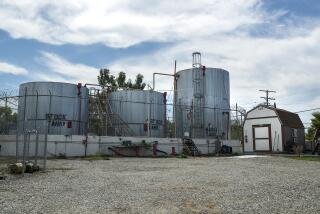Agencies admit failing to protect water sources from fuel pollution
The agencies charged with overseeing oil production and protecting California’s ever-dwindling water sources from the industry’s pollution all fell down on the job, one state official told a panel of peeved lawmakers Tuesday.
During a testy two-hour oversight hearing, officials from the California Department of Conservation, the department’s Division of Oil, Gas and Geothermal Resources and the state Water Resources Control Board promised senators a top-down overhaul of their regulation of the disposal of oil field wastewater.
But after a handful of recent embarrassing revelations about the division’s history of lackluster regulation, lawmakers questioned how they could trust agency officials to follow through, characterizing longstanding agency practices as corrupt and inept.
Sen. Hannah-Beth Jackson (D-Santa Barbara) called the division’s failings “endemic” and said that just reading background materials to prepare for Tuesday’s hearing caused her blood pressure to soar.
“There has been a serious imbalance between the role regulating the oil and gas industry and the role of protecting the public,” Jackson said.
Division of Oil, Gas and Geothermal Resources officials admitted last summer that for years they inadvertently allowed oil companies to inject wastewater — from fracking and other oil production operations — into hundreds of disposal wells in protected aquifers, a violation of federal law. Disclosures by oil drillers show high levels of benzene, a carcinogen, in the water that comes out of the ground with oil. Benzene is naturally occurring but extremely dangerous.
So far, the state has shut down 23 of the hundreds of injection wells that are in aquifers not approved for waste injection.
Agency officials have attributed the errors to haphazard record-keeping and antiquated data collection. And they have said that initial tests on nine drinking water supply wells found no benzene or other contaminants.
The federal Environmental Protection Agency has called the state’s errors “shocking” and said California’s oil field wastewater injection program does not comply with the federal Safe Drinking Water Act.
The state has been taking broadsides from the U.S. EPA, the state EPA and local water boards, all focusing on the troubled Underground Injection Control program, which is supposed to monitor the disposal of production water into below-ground wells.
The topic of Tuesday’s oversight hearing: “Is the underground injection control program working?”
A barrage of pointed questions indicated that the senators, at least, believed it was not.
Lawmakers several times said that Division of Oil, Gas and Geothermal Resources officials had requested more funding to solve intractable problems and had received beefed-up budgets beginning in 2010.
But the millions in new funding came with the requirement that the division annually report to the Legislature the results of its reform efforts. The agency has filed only one such report since 2010.
“The reports simply don’t come back,” said Sen. Lois Wolk (D-Davis). “This is a management issue. That’s the problem, not resources.”
Conservation department chief Mark Nechodom told Wolk he was unaware until recently that the Division of Oil, Gas and Geothermal Resources was required to file reports to the Legislature and vowed to get back on track.
In another exchange, state oil and gas supervisor Steven Bohlen was asked whether cyclic steam injection practices — in which steam is injected underground with such pressure that rock formations are crumbling and potentially creating dangerous sinkholes — are violating federal and state regulations.
Bohlen said that he thought so but that he hadn’t had time to “brush up on regulations.”
He also said the oil industry’s technology had outpaced the state’s regulations, many of which have remain unchanged for decades.
Bohlen was also asked why the state agency said it will continue to allow, in some circumstances, additional injection wells in aquifers the EPA considers to be off limits.
Bohlen responded by saying that Division of Oil, Gas and Geothermal Resources officials believed those aquifers would probably become approved for injections in the future.
“But isn’t it violating federal law now?” asked Sen. Ben Allen (D-Santa Monica).
Bohlen did not respond.
Lawmakers also asked officials at the state Water Resources Control Board why they allowed injection wells to operate in high quality water sources.
Jonathan Bishop, chief deputy director of the board, said his agency took the word of the division that the wells were legally permitted.
“We relied on their expertise,” Bishop said. “In hindsight, maybe we should have done independent analysis. We didn’t.”
As each agency took its blows from the oversight committee, Nechodom said, “We all fell down.”
More to Read
Start your day right
Sign up for Essential California for news, features and recommendations from the L.A. Times and beyond in your inbox six days a week.
You may occasionally receive promotional content from the Los Angeles Times.







